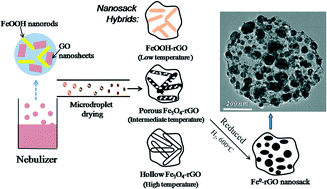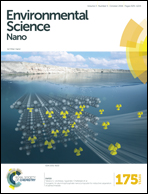Aerosol synthesis of phase-controlled iron–graphene nanohybrids through FeOOH nanorod intermediates†
Abstract
Iron-based nanoparticles form the basis for a host of sustainable alternative technologies based on this earth-abundant, low-toxicity element that can adopt a variety of oxidation states, crystal phases, and functions. Control of size, shape, and phase stability is a challenge for many nano-iron-based technologies, especially those involving Fe0 that is susceptible to oxidation under ambient conditions. This article presents a continuous method for hybridizing Fe-based nanoparticles with carbon in the form of graphene-encapsulated Fe-based particles with core–shell symmetry that allows flexible control of iron particle size, shape, and phase stability. The method uses FeOOH nanorods and graphene oxide as precursors, and subjects them to an aerosol-phase microdroplet drying and annealing process to yield a range of Fe/C nanohybrids whose structure can be controlled through adjustment of aerosol process temperature and post-synthesis thermal treatment conditions. We demonstrate that FeOOH nanorods can be successfully encapsulated in graphene, and transform during annealing into encapsulated Fe3O4 or Fe0 nanoparticles by reductive fragmentation, where the graphene nanosack acts as a carbothermic reductant. The hybrids are characterized by vibrating sample magnetometry and Cr(VI) removal rates in aqueous media. The Fe0–graphene hybrids show high activity, good stability, and good recyclability in aqueous Cr(VI) removal due to the effect of graphene encapsulation. The present work suggests this rapid and continuous synthesis method can produce stable Fe-based materials, and can be extended to other metal systems, where graphene encapsulation can induce in situ reduction of metal oxide precursors into zero-valent metal–graphene hybrids.


 Please wait while we load your content...
Please wait while we load your content...